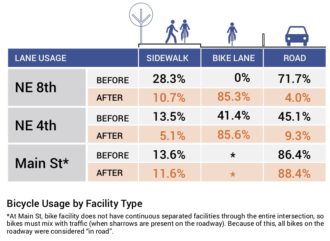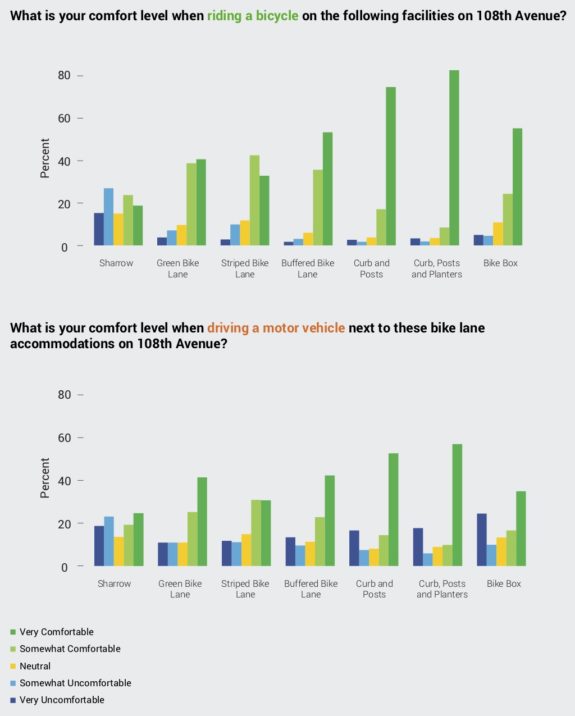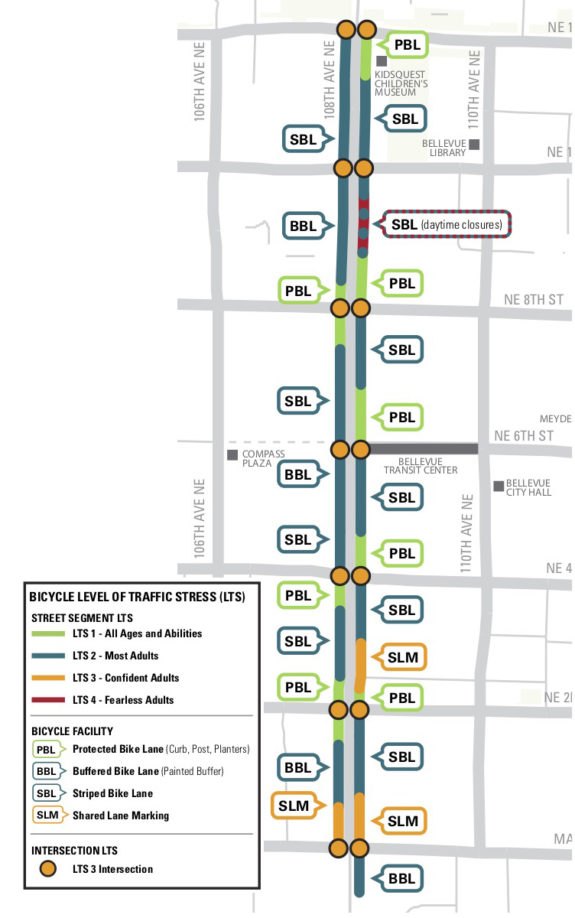
The City of Bellevue may have just conducted the most thorough study of a bike lane pilot project ever. The 31-page report (PDF) about the 108th Ave NE bike lane in the Eastside city’s downtown core found that bicycling increased 32%, sidewalk biking rate was reduced by more than 60% and zero collisions involving people biking have been reported.
And these results come from a bike lane design that is not even fully protected. Some sections only have paint, and one pinch point section even requires mixing with general traffic. So these results still have room to improve.
The Bellevue City Council voted last week to keep the pilot bike lane. But the city is also learning from what they observed and from survey results to make it better. And the city is also looking at how to best create an east-west protected bike lane connection, likely on Main Street. Cascade Bicycle Club has a handy online form so you can let Bellevue know you support their bike lane work and would like to see it grow to Main.
Protected bike lanes work best, say people … driving?
The extensive studying also turned up some possibly surprising results. For example, their survey found that people feel most comfortable when bike lanes are separated and protected whether they are biking or driving:
Level of Traffic Stress
The study also included a Level of Traffic Stress analysis, which is based on comparing measured vehicle speeds and volumes to the level of bike protection provided. Segments are rated from 1 to 4, with one being “all ages and abilities” and 4 being “fearless adults.” So, for example, a slow residential street with very low traffic volumes might get LTS 1 even without bike lanes. But a busy street (like a downtown street) would need a significant level of protection to get the same rating.
Using this analysis, Bellevue’s transportation staff determined that only a few segments of the pilot bike lane get the top rating, and no intersection rises above LTS 3. So they are being very transparent about where they have room for improvement, which is great:
I wonder how Seattle’s 35th Ave NE street designs would have compared under this analysis system, for example. Perhaps SDOT should consider this as a tool for explaining bike elements of their projects.
Maybe this analysis of the 108th Ave NE pilot project is way overkill. But then again, now we have answers and hard data for essentially every question someone could ask. Did it increase travel times for people driving? No. Did it slow buses? No (it actually improved bus times). Did it increase collisions? No. Did the extra protection really help the bike lane work better? Yes. Did the lane attract bike share trips? Yes. Did it decrease sidewalk biking? Yes.
Hopefully the city can also extrapolate the results of this study to inform their other needed bike lanes, since they can’t (or shouldn’t) spend this much time, energy and funding on every single bike lane. Bellevue has a lot of work to do before they have a connected network of bike routes that hit LTS 1 or 2, but this is a great study to stand on when designing and building them.










Comments
15 responses to “Biking increased 32% thanks to downtown Bellevue bike lane + City will keep it, debates expanding network”
I had to go to Bellevue for a medical appointment last week, and my head was spinning from all of the bicycle riders I saw just in a space of about 5 minutes. Awesome! I grew up in Lake Hills, and any street outside the neighborhoods felt like an expressway. You knew your place: IN A CAR.
Seattle has an LTS map at:
https://www.seattle.gov/transportation/projects-and-programs/safety-first/vision-zero/resources/bicycle-level-of-traffic-stress
It seems there’s some room for improvement, though—I don’t see any of the downtown PBLs on it. With those incorporated, a modified version showing only the level 1 or 1+2 networks might be a useful resource when talking to people who don’t ride bikes and still haven’t grasped the all ages and abilities concept.
I’m guessing the Kemper Freeman folks were the ones who were uncomfortable with biking (and transit and walking) across the board.
It’s amazing how vocally opposed they are to anything that doesn’t involve expanding vehicle infrastructure – of course at no cost to drivers, highways should be toll-free, on-street parking should be required and free, etc…
But but but who will SAVE BELLEVUE? Clearly all the businesses must be out of business now with the bike lanes.
As one who actually lives on 108th Ave, to say the bike lane has not increased travel times is absolute BS. Try to drive northbound from the High School anytime it lets out. Traffic is backed up at least to the entrance to the HS (1/4 of a mile). This is a result of turning the entire right lane into a bike lane and taking away the right on red. People now cut through Surrey downs as soon as they get to SE 2nd. I wonder what people riding bikes would do when traffic is backed up? So few people on bikes benefit from this arrangement at the expense of so many peoples time.
You don’t have to sit in that backed up traffic :) Jump on your bike and join us. You’ll be happier, more energetic, save money, and live longer to boot.
Personally I’d rather someone like that stay in their car and be miserable. People with attitudes like this are why I will never bike to or spend money in bellevue.
This article didn’t show how many people actually used these lanes. If usage went up 80 percent it could be from 10 in a day to 18 in a day. From reading it all we know is usage was higher but that doesn’t necessary mean it was all that impactful unless they had stated how many cyclists actually moved into the lanes as well. One can wax all positive about it but that’s not justified based on the article.
If you read the study it noted peak usage of 135 bikes in a day hardly ground breaking with the percentage increase not being as impactful because the base number was low. Also the before period was about two weeks and the after was measured over six months the latter sample period could be skewed.
Not saying this isn’t good news anyway but I’m wondering if it was intentional that the author didn’t mention this key figure which provides more perspective and context to the percentage.
This isn’t surprising being this Blog has an agenda which isn’t always balanced.
There arent too many bike riders in bellevue. I bike there every workday from issaquah. 108th is good for those comuting across i90 from rhe seattle side. I ocasionally use it, but its out of the way for the direction Im heading. In order to see that 135 bikes per day number increase they will need much better infrastructure. Its just too dangerous most places in bellevue for pedestrians. I do enjoy passing all the fools in cars stuck in traffic during rush hour. So many cars!
Yeah I ride through there all the time and did the 90 commute for years. it’s a ghost lane most the time but riding through Bellevue is a big too much for most cyclists. It is interesting the data was taken during the warmer part of the year I guarantee that 135 will be way lower in wetter periods. It is satisfying to ride through there when traffic is backed up.
The utility of the 108th Ave. protected bike lanes is limited today, because it’s a short stretch that doesn’t connect to anything. In the future, this will change – it will eventually connect to the Spring District and the ERC trail – but that’s not an argument against doing what we can to improve things today. After all, if wait for everything before building anything, that’s a perfect recipe to just end up with nothing.
Just so you get the significance of the 30 +% increase in bike trips on 108th Dem. Bike lanes in Bellevue. “Before” daily trips 92 trips reported paren actually 95 when Memorial Day was is excluded from the average trips paren and the after the bike lane was installed grew to 125 daily trips. Show the increase actually was from 95 to 125 trips on a daily basis or 31 additional trips on this street. Data from Bellevue limebike Bike Share program which started the same day as the demo bike lane shows that 25 daily trips from The Bike Share program used hundred and eight Avenue Northeast and 6 bicycles that previously used the sidewalk during the before data use the bike lane in the after data. Thus the bike lane itself generated zero new traps transferred six trips from the sidewalk to the Lane and the Bike Share program added 25 trips to the street. There is no data that indicates the demonstration bike lane actually attracted any new bike trips to downtown.
Bellevue is going through the same struggles as Tysons Corner in Virginia: both had extensive car infrastructure that was extremely hostile to pedestrians and cyclists, both are growing quickly, and both have realized in the past decade that people want to live in places where you can walk and bike to get around. Drivers in both places aren’t as used to seeing and dealing with cyclists much less yielding the huge swaths of land granted to them for free which leads to a lot of dismissal and aggression. The change is welcome, and it will make both areas much more livable.
I’m surprised that the intersection at 108th & 8th is listed as LTS 1 – the stop line for the southbound bike lane (not sure about the northbound one yet) is about 5′ behind the stop line for the southbound right turn lane. Without a separate signal for cyclists, it’s just asking for a right hook. You can see the problem clearly here:
https://goo.gl/maps/cj9T9ftTazPxRnBo7
Yes, it is not a great design, and the magnetic sensor loop there can be a bit iffy which makes things worse as it will allow a right turn even with a bike present. I’ve had to leave the bike lane and go sit over the car lane sensor to trigger it late at night. During peak hours I creep forward so the driver turning right is well aware I am there.